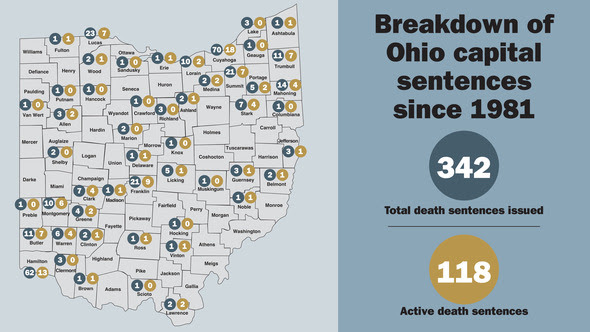COLUMBUS, Ohio — Ohio’s capital punishment system continues to face significant challenges, with no executions carried out in more than six years, according to the newly released 2024 Capital Crimes Report from Attorney General Dave Yost’s office.
“The only thing that has changed? The killers got a year older,” Yost stated in the report. “There needs to be some real progress – until that happens, Ohio cannot fulfill its promise of justice.”
The annual report, mandated by state law, reveals that since Ohio enacted its death penalty legislation in 1981, 337 individuals have received 342 death sentences. However, only 56 of these sentences—roughly one in six—have been carried out, with the last execution occurring in July 2018.
Ohio’s Death Row Population by Region
Currently, 116 inmates await execution on Ohio’s Death Row, with cases distributed across the state’s various regions. The regional breakdown highlights how capital punishment cases are distributed throughout Ohio’s judicial districts.
Northeast Ohio
Northeast Ohio accounts for approximately 38% of the state’s death row population with 44 inmates:
- Cuyahoga County: 20 inmates
- Trumbull County: 7 inmates
- Summit County: 7 inmates
- Stark County: 5 inmates
- Mahoning County: 4 inmates
- Lorain County: 2 inmates
- Portage County: 2 inmates
- Medina County: 2 inmates
- Ashtabula County: 1 inmate
- Erie County: 1 inmate
- Ashland County: 1 inmate
Southwest Ohio
The Southwest region, including Cincinnati and Dayton, accounts for approximately 25% of death row cases:
- Hamilton County (Cincinnati): 18 inmates
- Butler County: 6 inmates
- Montgomery County (Dayton): 5 inmates
- Warren County: 2 inmates
- Greene County: 1 inmate
Central Ohio
The Columbus area and surrounding central counties represent about 20% of cases:
- Franklin County (Columbus): 13 inmates
- Licking County: 3 inmates
- Fairfield County: 2 inmates
- Delaware County: 2 inmates
- Pickaway County: 1 inmate
- Madison County: 1 inmate
Northwest Ohio
The Toledo region and northwestern counties account for approximately 12% of cases:
- Lucas County (Toledo): 8 inmates
- Allen County: 3 inmates
- Wood County: 2 inmates
- Hancock County: 1 inmate
Southeast Ohio
The less populated southeastern region has the fewest death row inmates at approximately 5% of the total:
- Belmont County: 2 inmates
- Muskingum County: 2 inmates
- Athens County: 1 inmate
- Washington County: 1 inmate
Longest-Standing Cases
Some of Ohio’s oldest death penalty cases remain unresolved after decades. While Northeast Ohio has several long-standing cases such as Anthony Apanovitch (Cuyahoga County, January 1985) and Danny Lee Hill (Trumbull County, February 1986), other regions have similarly aged cases:
- David Allen (Cuyahoga County, July 1991)
- James Frazier (Lucas County, May 1991)
- John Stumpf (Guernsey County, May 1984)
- William Montgomery (Lucas County, February 1986)
Legal Challenges and Execution Delays
The report indicates that condemned inmates in Ohio spend an average of more than 22 years on Death Row before an execution date is set, largely due to extensive appeals processes.
The case of Danny Lee Hill from Trumbull County illustrates these prolonged legal battles. Hill has filed more than 25 appeals since being sentenced nearly 40 years ago for the rape, torture, and murder of a 12-year-old boy. Just last week, a federal appeals court permitted Hill to file yet another challenge to his conviction and sentence, requiring a federal trial judge to review evidence that Ohio courts have already ruled should not affect his conviction.
In 2024 alone, one Death Row inmate was resentenced to life in prison with the possibility of parole, while three others were deemed ineligible for the death penalty due to intellectual disabilities or mental illness. In June, one new death sentence was imposed in Ohio.
Execution Method Challenges
Beyond legal hurdles, Ohio faces significant challenges in obtaining drugs for lethal injections, as pharmaceutical companies increasingly refuse to supply medications for executions.
Attorney General Yost has identified two potential paths forward. The first involves federal intervention, with President Trump directing U.S. Attorney General Pam Bondi to ensure states have access to execution drugs. Yost welcomed this approach in a March 5 letter to Bondi, writing that “without the assistance of the federal government, Ohio’s situation is unlikely to change.”
The second option involves legislative action to approve nitrogen hypoxia as an alternative execution method. Other states have already moved in this direction, with Louisiana using nitrogen in March to perform its first execution in 15 years, and Alabama carrying out four death sentences using nitrogen since January 2024.
The Path Forward
The attorney general’s report emphasizes that the stalemate in Ohio’s death penalty system cannot continue indefinitely. While the legal and procedural challenges remain complex, Yost has called for decisive action from state lawmakers and officials.
“There are two paths available to Ohio to enforce the laws on our books,” Yost concluded. “Pick one.”
As death row populations across all Ohio regions continue to age, with some inmates having spent more than three decades awaiting execution, questions about the efficacy and purpose of capital punishment in the state grow increasingly urgent. The 2024 Capital Crimes Report suggests that without significant changes to either the process or the method, Ohio’s death penalty system may remain essentially dormant despite the dozens of sentences that remain on the books.
Discover more from Northeast Ohio News
Subscribe to get the latest posts sent to your email.










